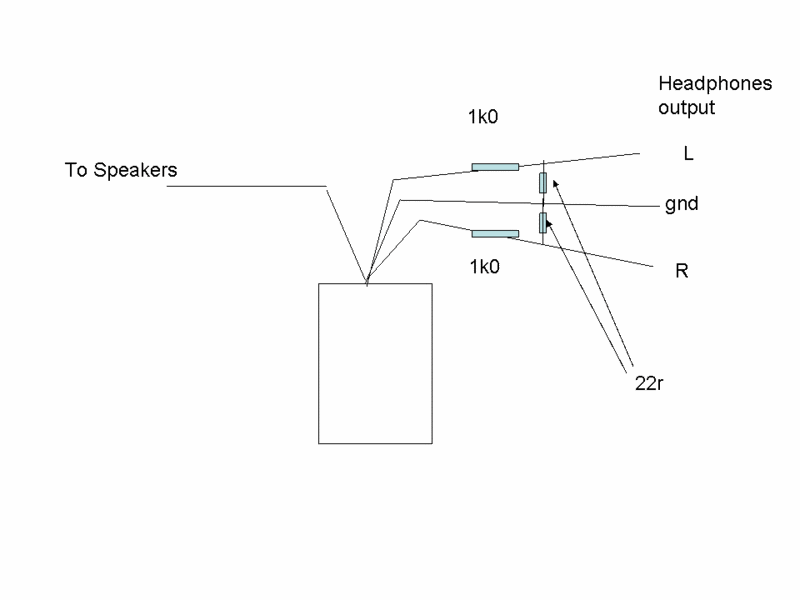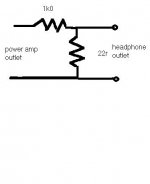Hi guys,
I am not really good at the electrical calculations and conversation.
can someone let me know if I can use this transformer
http://sg.farnell.com/jsp/search/productdetail.jsp?sku=9532455
for the lm3886 amp from chipamp.com
Many thanks in advance.
Rgds,
Marcus
I am not really good at the electrical calculations and conversation.
can someone let me know if I can use this transformer
http://sg.farnell.com/jsp/search/productdetail.jsp?sku=9532455
for the lm3886 amp from chipamp.com
Many thanks in advance.
Rgds,
Marcus
Hi,
most solid state amps can drive any resistance above the minimum. So I meant 4ohms to infinity.
It is VERY unusual for SS amps to have an upper limit for load resistance and most will operate safely with the output open circuit, so your 600ohm headphones are no problem.
But you will need an attenuator to drive the headphones.
They will only need a few mW of input to sound VERY loud.
most solid state amps can drive any resistance above the minimum. So I meant 4ohms to infinity.
It is VERY unusual for SS amps to have an upper limit for load resistance and most will operate safely with the output open circuit, so your 600ohm headphones are no problem.
But you will need an attenuator to drive the headphones.
They will only need a few mW of input to sound VERY loud.
Hi,
adding a resistor in series with the headphones will cut volume slightly.
But, you need an attenuator.
You should be looking at -20db to -40db to be effective.
A little experimentation will give you some answers.
If you want to start with 220R in series with the phone output and try adding 22r across the phone output. This will give you approximately -20db. See how loud they sound when your volume is set to normal level and how the control feels over a range that you might listen to.
adding a resistor in series with the headphones will cut volume slightly.
But, you need an attenuator.
You should be looking at -20db to -40db to be effective.
A little experimentation will give you some answers.
If you want to start with 220R in series with the phone output and try adding 22r across the phone output. This will give you approximately -20db. See how loud they sound when your volume is set to normal level and how the control feels over a range that you might listen to.
Hi M,
no you need two attenuators, each separately connected to the respective output.
the 220r is in series with the output. The 22r goes from output to return (audio ground). The headphone output is across the 22r.
If the power amp output is about 20Vac maximum, then the 220r will see a maximum dissipation of about 1W8, use three 600mW resistors in parallel (680//680//680=227r).
But, I would use 1k0 in parallel, each will be asked to dissipate 400mW maximum. You can use just one 1k0 to try the volume settings. If this is too quiet then add a second 1k0 in parallel to increase the headphone output. You should not need to add a third but that option or even four, is available depending on the sensitivity of your phones.
So go and buy 10 off 1k0 600mW metal film and 2 off 22r metal film.
no you need two attenuators, each separately connected to the respective output.
the 220r is in series with the output. The 22r goes from output to return (audio ground). The headphone output is across the 22r.
If the power amp output is about 20Vac maximum, then the 220r will see a maximum dissipation of about 1W8, use three 600mW resistors in parallel (680//680//680=227r).
But, I would use 1k0 in parallel, each will be asked to dissipate 400mW maximum. You can use just one 1k0 to try the volume settings. If this is too quiet then add a second 1k0 in parallel to increase the headphone output. You should not need to add a third but that option or even four, is available depending on the sensitivity of your phones.
So go and buy 10 off 1k0 600mW metal film and 2 off 22r metal film.
AndrewT said:Hi,
You don't need to switch the ground/return.
Just switch the two output leads.
With a load of 1022r on each output you can leave them permanently connected and just insert/remove the headphones from the socket (1/4inch TRS?).
Hi, I edited the picture slightly, just want to make sure i am on the right track. Yes I am likely to be using a TRS, with this load of 1022r, what should the resistor wattage be?
And also at such a high load will my lower impedance phones be fried by the output.

Hi,marcusdeming said:with this load of 1022r, what should the resistor wattage be?
And also at such a high load will my lower impedance phones be fried by the output.
calculate the power from P=I*V
Why are you planning to fry (cook?) your headphones?
AndrewT said:
Hi,
calculate the power from P=I*V
Why are you planning to fry (cook?) your headphones?
Hi Andrew,
No not planning to cook the phones, just wondering if they will be damage, cos at this configuration i am planing to use it for my 600 ohms.
I was told this formula b4 but don't really understand it due to the units
Hi,
P=I*V the units are volts and amps.
eg,
maximum output from the amplifier=20vac (=28.3Vpk)
I=V/R=20/1022=0.0196Aac (Ohm's law)
P=V*I=20*0.0196=0.39W this is about 2/3rds of the rating of a 600mW resistor. That is precisely why I suggested using 1k0 as the dropper. It guarantees that you cannot overheat it on continuous maximum sinewave output.
Each additional parallel 1k0 similarly cannot be overheated.
The other equations you can use are:-
P=I*V=V*V/R=I*I*R,
just select the version for which you know the values with just one unknown.
P=I*V the units are volts and amps.
eg,
maximum output from the amplifier=20vac (=28.3Vpk)
I=V/R=20/1022=0.0196Aac (Ohm's law)
P=V*I=20*0.0196=0.39W this is about 2/3rds of the rating of a 600mW resistor. That is precisely why I suggested using 1k0 as the dropper. It guarantees that you cannot overheat it on continuous maximum sinewave output.
Each additional parallel 1k0 similarly cannot be overheated.
The other equations you can use are:-
P=I*V=V*V/R=I*I*R,
just select the version for which you know the values with just one unknown.
Hi,
tolerance has no effect on sound quality here.
However keeping circuits close to their design parameters can demand some close tolerance components. This is particularly so when two halves monitor the same thing and the difference between two outputs becomes the needed signal.
But, for your headphone attenuator, 600mW, 1% metal film will do just nicely.
I used to buy my resistors in tens.
Now, I buy 100off each value I run short of.
tolerance has no effect on sound quality here.
However keeping circuits close to their design parameters can demand some close tolerance components. This is particularly so when two halves monitor the same thing and the difference between two outputs becomes the needed signal.
But, for your headphone attenuator, 600mW, 1% metal film will do just nicely.
I used to buy my resistors in tens.
Now, I buy 100off each value I run short of.
AndrewT said:Hi,
tolerance has no effect on sound quality here.
However keeping circuits close to their design parameters can demand some close tolerance components. This is particularly so when two halves monitor the same thing and the difference between two outputs becomes the needed signal.
But, for your headphone attenuator, 600mW, 1% metal film will do just nicely.
I used to buy my resistors in tens.
Now, I buy 100off each value I run short of.
Whoa 100off each value, you must have got a lot of projects going on.
Anyway, will a 0.5w or 1w be fine, doubt i can get any 600mw over here.
btw i don quite understand what you meant here:
"This is particularly so when two halves monitor the same thing and the difference between two outputs becomes the needed signal. "
Can i do the same sort of connection to other headphones amp? will it improve the tracking?
A differential amplifier amplifies the difference between two signals. The two amplifiers must amplify each half very accurately if the output is to be a good copy of the input differential. Many schematics show <=0.1% for the resistors in the measuring part of the diff amp.This is particularly so when two halves monitor the same thing and the difference between two outputs becomes the needed signal.
The LTP at the front end of a power amp is a similar example where close macthing of parameters is required.
- Status
- This old topic is closed. If you want to reopen this topic, contact a moderator using the "Report Post" button.
- Home
- Amplifiers
- Chip Amps
- Transformer for LM3886

